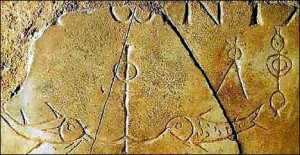This is a reposting of some of Larry’s updating of his essay on monotheism.
“Monotheism” in/and Ancient Roman Religion: The Continuing Discussion
by larryhurtado
Having just tried to do a last-minute updating of my essay, “How Do We Recognize ‘Ancient Jewish Monotheism’ in the Hellenistic and Roman Periods?,” scheduled to appear in the next issue of Journal of Ancient Judaism, I want to mention a recent multi-author volume with some high-quality contributions on a number of matters relating to religious change/developments in the Roman period: One God: Pagan Monotheism in the Roman Period, eds. Stephen Mitchell & Peter Van Neffelen (Cambridge: Cambridge University Press, 2010).
The volume arose from a project led by Mitchell and funded by the UK Arts and Humanities Research Council on “the intellectual background to pagan monotheism”. In addition to a fine Introduction by the editors, the other contributions are by Peter Van Nuffelen (“Pagan Monotheism as a Religious Phenomenon”), John North (“Pagan Ritual and Monotheism”), Michael Frede (“The Case for Pagan Monotheism in Greek and Graeco-Roman Antiquity”), Alfons Furst (“Monotheism Between Cult and Politics: The Themes of the Ancient Debate between Pagan and Christian Monotheism”), Christoph Markschies (“The Price of Monotheism: Some New Observations on a Current Debate about Late Antiquity”), Angelos Chaniotis (“Megatheism: The Search for the Almighty God and the competition of Cults”), Nicole Belayche (“Deus deum . . . summorum maximus [Apuleius]: Ritual Expressions of Distinction in the Divine World in the Imperial Period”), and Stephen Mitchell (“Further Thoughts on the Cult of Theos Hypsistos”).
Individually, these are thought-provoking discussions by recognised experts, and collectively this is an important state-of-discussion volume that not only addresses specifically the question of “monotheism” in the Roman period but also wider issues of religious change/development in that time. I particularly found the Introduction and the essays by Van Nuffelen and North stimulating. I give a few tidbits below.
From the “Introduction” (p. 14): “Only when Christianity became the dominant system in the fourth century did pagans begin to develop new ideas about their god (or gods), and thus became, in a much stricter sense, rivals to Christians. It is only then that pagan monotheism can be identified as a distinctive religious movement.” Or how about this: “The Roman Empire was the most fertile period of religious innovation in antiquity, perhaps even in any period of history” (pp. 14-15).
From Van Nuffelen’s essay: “It is hard to find undisputable documentary evidence of pagan monotheistic cults in the Roman Empire.” (p. 24). And on p. 26, this warning about deriving a wrong impression from pagan philosophical speculations about the gods, “that a discussion of philosophical concepts tells us something about wider religious life, whereas in reality it may only reflect the speculations of a very restricted group of the upper class.”
From North’s essay, on assertions that beliefs didn’t feature in ancient pagan religion: “It makes no sense, in my view, to say that the ancients did not believe in their own gods; but, having accepted that they did, we still have to face the issue of how we are to discuss and analyse the concept of ‘beliefs’ in a context so different from those with which we are familiar today.” (p. 35) And in response to claims of some sort of “inevitable” drift toward monotheism in ancient societies as they became more complex, the problem is “that both the idea of monotheism and the increasing complexity of societies had been in existence for many centuries in the Mediterranean areas and in the Near and Middle East without having the ffects the throry proposes. It is not at all obvious that the fourth century AD is qualitatively different in social or political organisation from many centuries that preceded it, during which polytheism and its rituals had been maintained unproblematically in a huge reange of societies of very different types, many of great complexity.” (p. 49)
One final comment from North: “There does, however, seem to be one crucial new element, introduced by the proponents of the new religions. They seem by the third century AD to be putting forward statements expressing the relations between men and deities in verbal propositions. It seems extraordinarily difficult to do this in the context of the type of paganism that we have been discussing. It is not just that Christians quite soon produce a creed, where the pagans never had one; but that it is very difficult to imagine what a pagn creed could ever have been.” (p. 49).
For students of early Christianity, this volume richly repays the reading of it.













